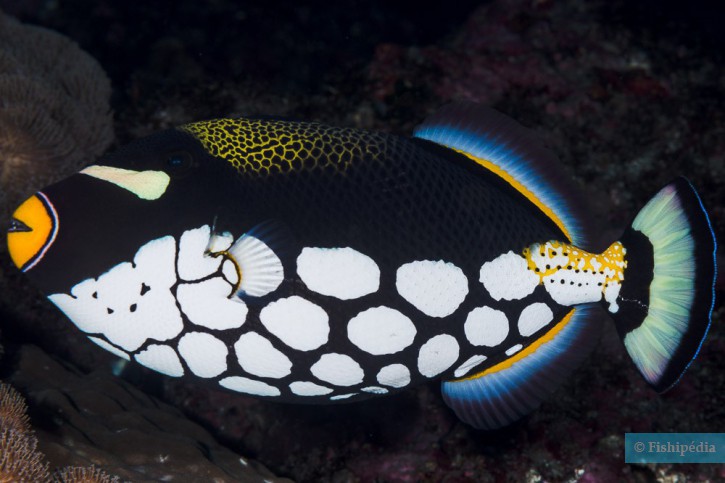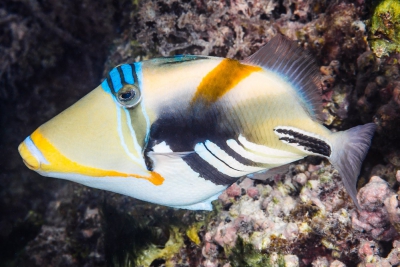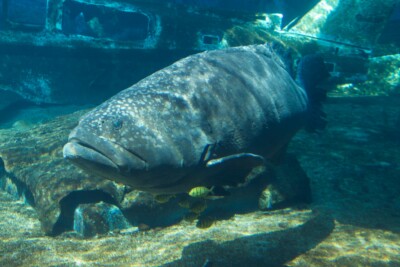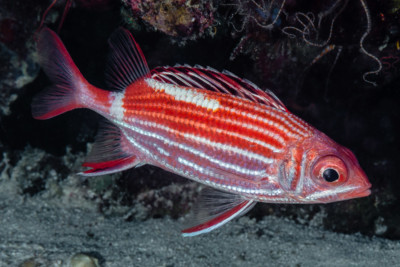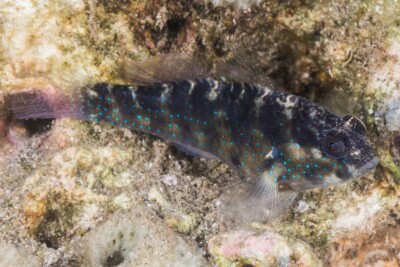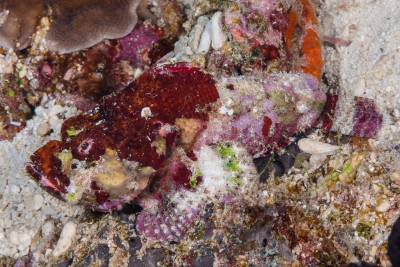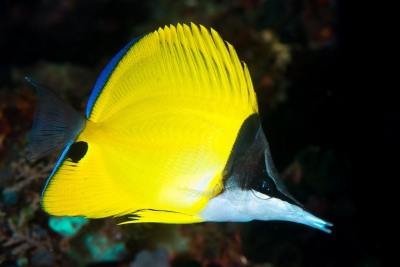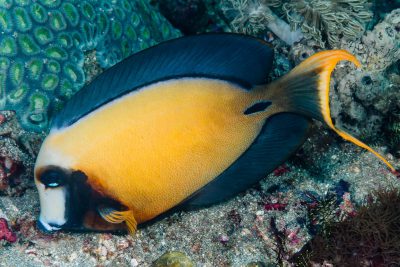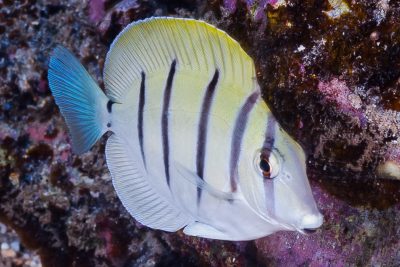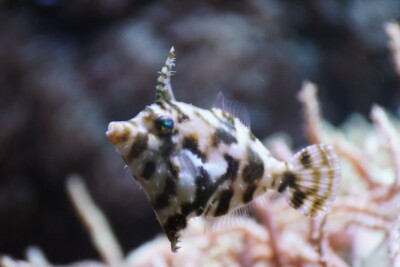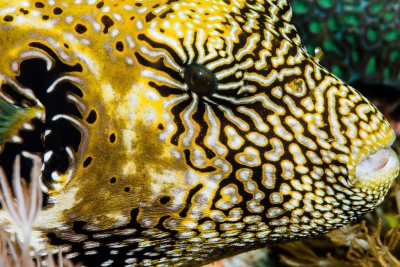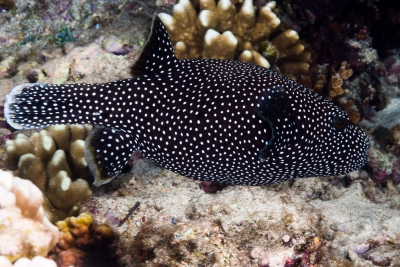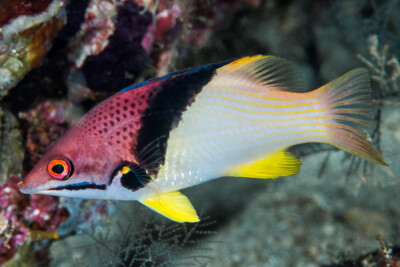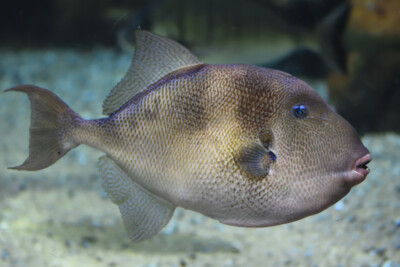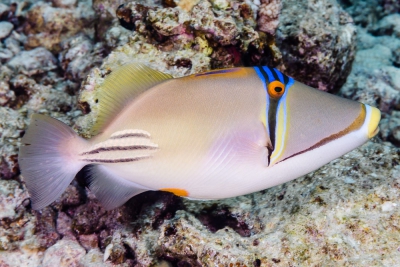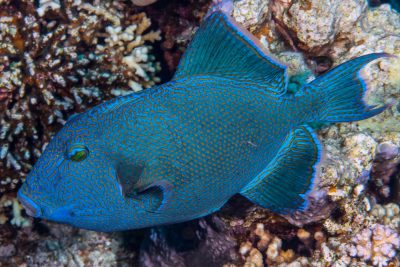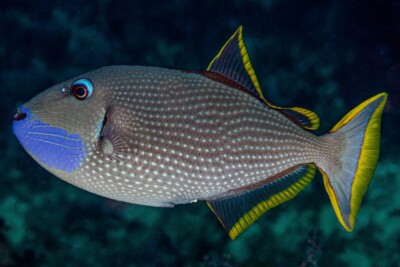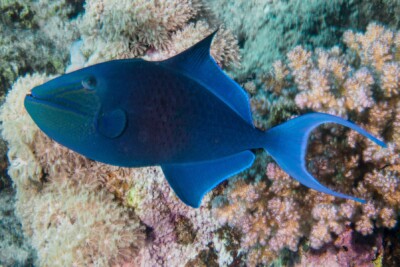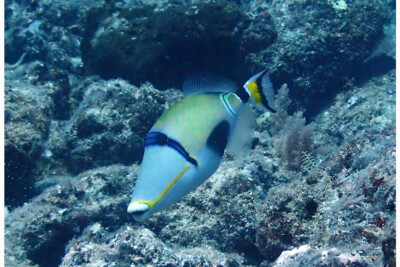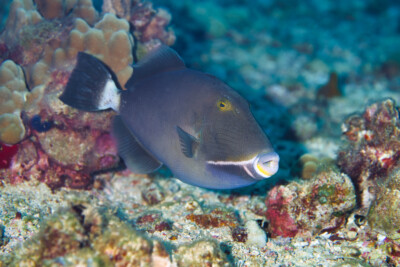clown triggerfish
| Family | Balistidae |
|---|---|
| Genus | Balistoides |
| IUCN category (World) | LC |
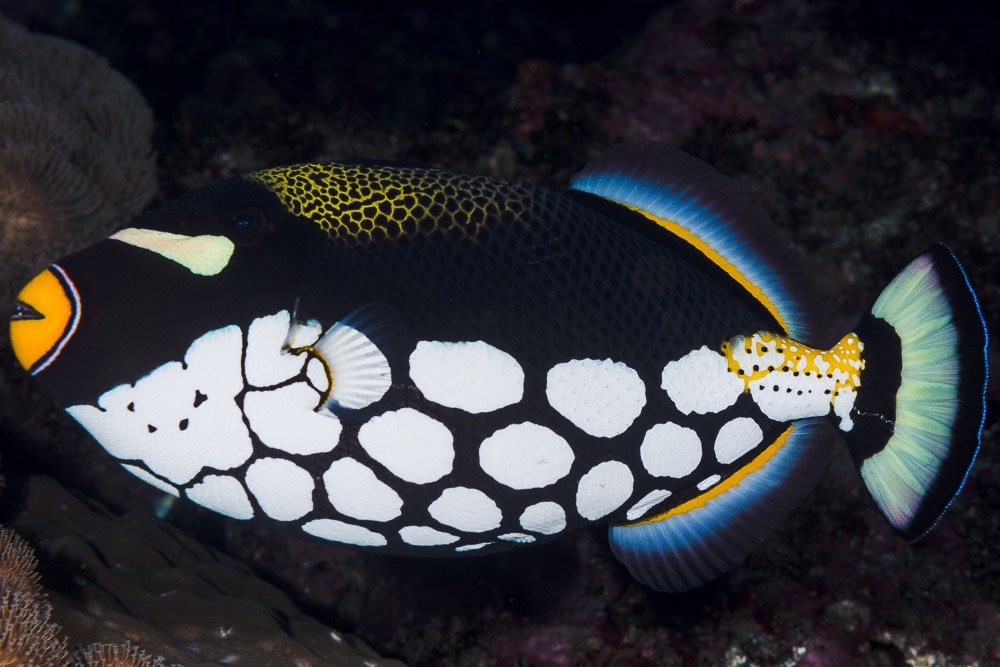

Introduction
Balistoides conspicillum, also known as clown triggerfish, is a tricolored marine fish remarkable for its spectacular patterns. Its body is black with large rounded white spots on the ventral part, while the snout and mouth area have yellow to orange hues. Sought after for the aquarium trade, it is also consumed in some regions.
Who is it?
Morphology
-
Type
-
Average size45 cm
-
Maximum size50 cm
-
ShapeOval
-
Patterncircle pattern
-
Type
-
Average size45 cm
-
Maximum size50 cm
-
ShapeOval
-
Patterncircle pattern
How to recognize This fish ?
The clown triggerfish can reach 40 cm in length. Its body is oval, laterally compressed, with a concave dorsal profile and a convex ventral profile. The lips are thick and cylindrical.
It has three dorsal spines: the first, long and pointed, can be locked in a vertical position and serves as a means of defense. The scales are thick and covered with protuberances, especially on the cheeks and the caudal peduncle, which also bears rows of spines. A large white or yellowish spot runs across the caudal fin. The relatively small mouth is equipped with powerful teeth that allow it to crush shells and crustaceans.
Sexual dimorphism
There is no marked sexual dimorphism. The distinction between males and females is difficult outside of the breeding periods.
Behaviour & Life cycle
-
dietcarnivorous
-
Sociabilitysolitary
-
territorialYes
-
Way of livingdiurnal
A solitary species, the clown triggerfish frequents clear reef zones and spends most of its time swimming among rocks, drop-offs, and caves. Adults often swim along deep drop-offs, while juveniles remain hidden in shallow cavities. When threatened, the animal can seek refuge in a crevice and lock its first dorsal spine to anchor itself firmly. It displays aggressive behavior towards intruders, especially during the breeding season. It feeds on crustaceans, mollusks, tunicates, and sea urchins.
Reproduction
-
Reproductionovipare qui pond sur substrat découvert
Balistoides conspicillum is oviparous. Reproduction takes place in pairs on sandy or crushed coral substrates, typically on the outer slopes of reefs. Females deposit their eggs on the substrate, which are then fertilized and protected by the couple. Like other triggerfish, nest defence behaviour is vigorous.
Risks for humans
-
VenomousNo
-
BiteYes
Not venomous, but it can inflict painful bites if disturbed, especially near spawning sites. Like other triggerfish, it does not hesitate to charge divers who venture too close to its nest.
Origin and distribution
Geographic distribution & Conservation
The species is widely distributed in the Indo-Pacific region: from East Africa (including Durban and the Red Sea) to Samoa and the Line Islands, passing through Indonesia, Micronesia, and New Caledonia. It is present as far north as Sagami Bay (Japan) and as far south as the Great Barrier Reef, New South Wales, and Lord Howe Island (Australia).
Conservation status of populations (IUCN)
What is its habitat?
Natural environment characteristics
-
Temperature24 - 28 °C
-
Depth1 - 50 m
Biotope presentation
Balistoides conspicillum inhabits coral reefs rich in invertebrates, particularly clear and exposed areas of outer slopes. Juveniles hide in small deep cavities (beyond 20 m), while adults prefer drop-offs. The species is considered rare to uncommon over much of its range, but locally abundant. It is generally observed between 1 and 50 m, but can descend to 75 m.
Species of the same biotope
Main recommendations for fishkeeping
Deontology
In order to preserve wildlife, if you acquire this animal, it must not be released into the wild. See also, the Fishipedia charter.
Fishipedia supports the practice of responsible and environmentally friendly aquarium keeping. We encourage maintenance if it is motivated by a desire to understand the biological functioning of living things and if it is done with respect for animal life.
We believe that aquaristics is an opening to the discovery of aquatic environments, especially freshwater, and that this knowledge is necessary to better protect and respect these environments. Logically, we refute the compulsive purchase of animals that would not find a sufficient and / or adapted place in the host aquarium.
Our recommendations
-
Min volume2000 liters
-
Population min1
-
Temperature24 - 28 °C
-
pH (acidity)8.2 - 8.4
Characteristics
-
Difficulty breedingmoderate
-
Robustnessrobust
-
Behaviourmoderately aggressive
-
Availabilityoccasional
General reminders
It is strongly advised to read the complete dedicated file and to get information on the feedbacks of maintenance of the envisaged animal, this to avoid any potential conflict whose end result is generally the death of the individual (or the other inhabitants). It is important not to overload your aquarium to limit pollution. This will make maintenance easier.
General reminder on maintenance datas
Le démarrage d'un aquarium est une partie primordiale pour l'équilibre et le bien-être des poissons. Lorsque l'on met en eau un aquarium, l'eau passe naturellement par un cycle biologique : le cycle de l'azote. Celui-ci dure environ trois semaines. Tous les 2 jours, nous vous conseillons de tester votre eau jusqu'à ce que le taux de nitrite soit à zéro pendant plusieurs jours d'affilée.
Pour accélérer ce cycle, vous pouvez utiliser un activateur de bactéries comme JBL Denitrol. Cette solution riche en bactéries vivantes et enzymes permet une mise en place rapide du cycle de l'azote. Les poissons peuvent alors être introduits plus rapidement.
Il est important de tester l'eau de son aquarium régulièrement pour maintenir un environnement sain pour les poissons et les autres habitants. Les tests d'eau permettent de mesurer les niveaux de différents paramètres tels que le pH, la dureté totale, ainsi que les taux de nitrates, de nitrites et d'ammoniaque.
Pour réaliser ces tests, vous pouvez utiliser des produits d'analyse spécialisés tels que JBL ProScan qui permet de réaliser un diagnostic de l'eau directement via un smartphone. Il existe également des coffrets de tests plus classiques de bandelettes, comme JBL PROAQUATEST.
En cas d’usage de l’eau du robinet, vous pouvez utiliser un conditionneur d’eau de type Biotopol de JBL pour éliminer les substances nocives comme le chlore, le cuivre, le plomb et le zinc. Une eau trop dure ou trop calcaire peut être inadaptée à de nombreuses espèces tropicales d’eau douce. Si nécessaire, vous pouvez la couper avec de l’eau osmosée ou de pluie filtrée afin d’obtenir une dureté plus adaptée aux besoins de vos poissons et de vos plantes. Les conditionneurs d'eau garantissent une meilleure santé aux poissons et une meilleure croissance des plantes.
Chlorine and chloramine are dangerous for the health of animals. Used to disinfect water, these agents are present in significant quantities in tap water. We recommend using an anti-chlorine agent every time you change the water. In addition to chlorine, treatments and medicines sold for aquarium use sometimes contain dangerous heavy metals in high doses.
Specific needs for the clown triggerfish
The clown triggerfish is a marine species which lives naturally at a temperature between 24 °C and 28 °C. Nitrate levels should remain below 50mg/L. To keep the water clean and unpolluted, plan on changing 20% to 30% of the water volume each month. In seawater, it is also possible to remove nitrates using one of the following methods: Jaubert, denitrator on sulfur, biopeletts, vodka method.
The breeding of this species is accessible on condition of being well informed about its needs in aquarium . Any cohabitants must be chosen with care to avoid the loss of animals.
This species is generally available in specialized shops or from aquarium clubs. Specimens that have been bred for a long time are easier to breed, but special water parameters must be respected.
Builder fish
This fish has the particularity to dig its territory in the sand. Therefore, it is likely to uproot plants and modify the decor of the aquarium.
Formal incompatibilities
Cohabitation & Environment
In a community aquarium context, this species should be kept in a minimum volume of 2000 liters.
The clown triggerfish has a strong character. Its maintenance with territorial neighbors in an inadequate volume will generate stress. ndeed, it will not hesitate to fight to protect its territory and to dominate its neighbors. It is important to think carefully about the constitution of the future population to avoid this kind of inconvenience. The aquarium should be arranged so that each species can comfortably define its own territory.
The males of this species do not support each other, the maintenance of several of them in the same tank is strongly disadvised.
To best reproduce the biotope of this species, you can cover the bottom of the tank with sand and put a pile of stones to form caves.
Tips for feeding
The clown triggerfish is carnivorous.
This species can eat dry food (flakes, pellets), fresh food and frozen food. To avoid deficiencies, it is recommended to vary the types of food.
Feed animals in moderation to maintain good water quality. Meals should be eaten within 2–3 minutes, served in several small portions rather than a single large ration.
Uneaten food quickly decomposes, releasing ammonia, nitrites, and nitrates, which disturb the aquarium’s biological balance.
Make sure each species can access food properly, slower or bottom-dwelling individuals may require targeted feeding.Reproduction protocol
-
egg-laying protectionYes
Hybridization risks
In general, it is advised not to mix several species of the same genus or different varieties of the same species, to avoid the risks of hybridization.
These animals might interest you
To go further
Sources & Contributions
Participation & Validation
The Fishipedia team and specialist contributors are committed to providing high-quality content. However, although the information comes from scientific sources or testimonials from specialists, the cards may contain inaccuracies.

Adrien Falzon

Benoit Chartrer

Silvia Gomez

Aurélien Calas
Translation
Translation done with the valuable contribution of our translators, who make this information available to a wider audience. We sincerely thank them for their commitment.

Marine Kassel
Scientific partners
Tags
Species of the same family
Species of the same biotope
